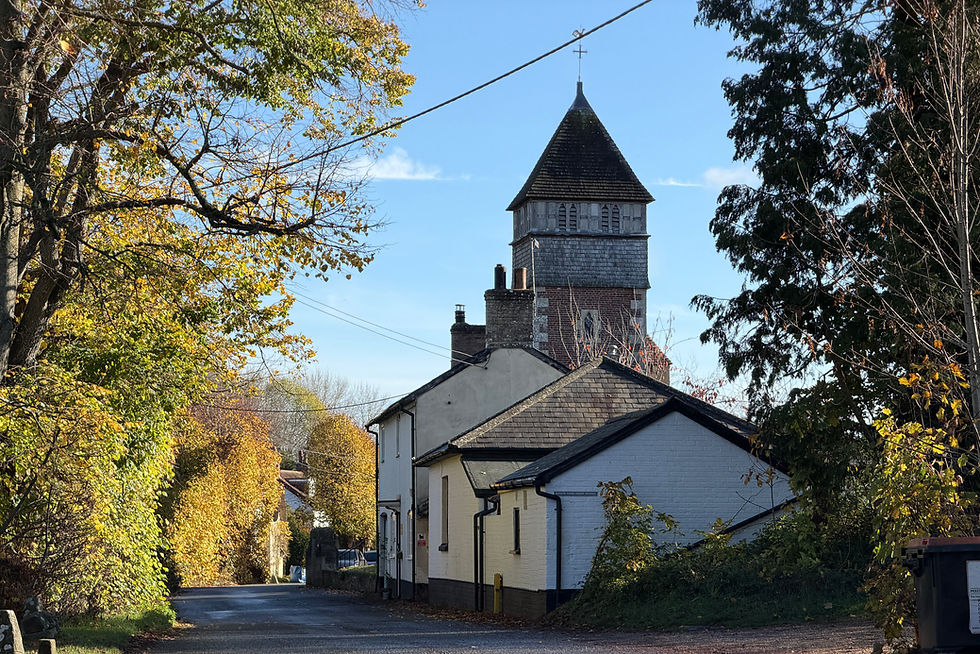The Coffin Trail from West Ashton and Steeple Ashton
- Glyn Coy
- Jul 8, 2021
- 3 min read
Updated: Jul 9, 2021
Before St John's Church was built in West Ashton in 1846, the villagers would use St Mary's Church in Steeple Ashton for funerals. To get there, they would transport the coffin across the fields along a right of way which is still referred to as the Coffin Trail. Having known about this route for some time, I decided to walk along it myself, devising a circular route which takes in both villages.

My journey began in West Ashton outside the church. It has strong connections to the Long family of Rood Ashton Hall who funded its construction. It sits at the top end of the village close to the A350, but is still elevated on a hill above the plain of the River Biss.

At the left side of the church is a gate, which takes you on to a right of way across the field behind. Crossing this takes you through the grounds of the village primary school before joining the main road through West Ashton.

After a short walk along the road, a public footpath on the left takes you in between the houses and gardens on to open fields. The right of way across the field can be tough to discern when the crops are growing, but this year I was able to roughly follow one of the tram lines, passing tree clumps along the way.
Here the view opens up to the left, as you are high up, looking down on Wiltshire's county town of Trowbridge in the distance. From this vantage point it looks like a rural town, flattering its rather run down status.

At this point you will also be traversing the rear of what is left of Rood Ashton hall. The Hall itself was mostly demolished in the 1970's, but what is left is still grand and is now a private house. Incidentally, there is a steam locomotive called "Rood Ashton Hall" which was built in Swindon in 1930 and is now I believe in the Tyseley Locomotive Works.
Eventually the path joins the minor road that links the two villages, where you cross over and continue the trail through the fields. Here, while the farmer had left the path uncultivated, the rapeseed crop was very overgrown, making the walk a bit tricky to navigate in late June. An earlier visit in the year when the crop was full of flowers was much easier.

In the next field, with Heath Hill Plantation to your left, you eventually hit a picturesque little bridge which crosses a stream into a small enclosed field known as Luffenham. The land here was given to the villagers in perpetuity in 1855 and is currently maintained by the Friends of Steeple Ashton. Going back to the bridge though, this was restored in 2020 by the stonemason Andrew Ziminski. It was his last job before the first lockdown which in his own words he "had to just abandon, make safe and finished 3 months later". Incidentally, Andrew has written a fascinating book on the history of building Britain through the eyes of a stonemason which is available here: The Stonemason.

Upon exiting Luffenham, the trail continues until you eventually join Butts Lane. Following this will bring you out to the village of Steeple Ashton. As you have approached the village along through the fields you will already have seen the imposing St Mary's Church, as it is such a large, cathedral like building. The church was rebuilt in the late 15th century, with the chancel rebuilt in 1853. Whilst in the village, do take some time to have a look around, it is a very picturesque place.

The journey back to West Ashton takes a slightly different route. You start along Butts Lane but instead of veering right back to Luffenham, you veer left to take a well marked route through fields to East Town Lane. As you walk this route look to your left, and you will have marvellous views of the escarpment up to Salisbury Plain. You can see Bratton Camp and Picquet Hill, and in the evening as the sun descends, the shadows and shapes of the hollows become clearer.

Heading across to East Town, you walk past the farm and turn left, following East Town Road all the way back to West Ashton. From here, it is a gentle walk down the main road towards the church, where again, views of Trowbridge open up which genuinely do flatter it.




















A lovely pictorial, Glyn. There's a good history of Rood Ashton House in this book: "Inheriting the Earth: The Long Family's 500 Year Reign in Wiltshire".🙂